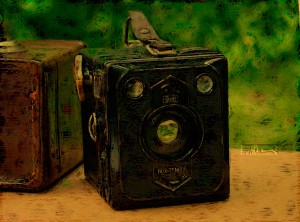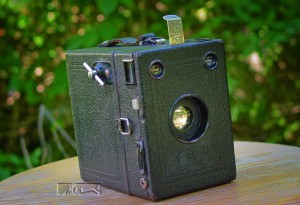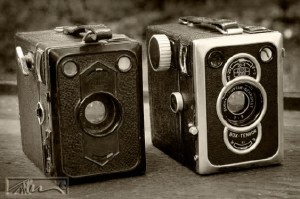Most box cameras were built long before I was born. My parents may have used one and my grandparents most certainly did. They were the consumer cameras of their day.
Besides pinhole cameras, box cameras are probably the most basic of all cameras. Not much more than a box and a lens, these cameras flourished during the early part of the 20th century as the camera for the masses. Easy to construct and easy to use, these simple and affordable cameras allowed millions of people to capture their daily activities. Found in nearly every household throughout the civilized world of the 1920’s to the end of World War II, these cameras produced millions of snapshot images of everyday life.
Most of these cameras were made from wood and covered with a pebbled grain cloth or paper. There were some that were made from paperboard and used a pinhole rather than a lens. More expensive versions were made from stamped metal and covered in leather. They had simple shutters and apertures.
Most of the time there was only a single aperture setting and a single instant shutter setting of about 1/60th of a second or slower. Many cameras also had a second setting that allowed for a long exposure. This setting was called the ‘T’ setting, which stood for time exposure. The lenses were for the most part fixed focal length and the viewfinders were simple and sometimes simply a wireframe. Very early models used a simple cord to activate the shutter. Box cameras are considered archaic by modern standards. Yet these wonderful tools made photographs with amazing dignity and charm.
Foremost among these wonderful boxes, was an amazing little camera made in Germany.
Made from the early 1920’s to the mid 1950’s, the Box-Tengor was considered by many to be the best box camera ever made. The things that set the BT ahead of its competition were a sophisticated shutter as well as a focusable lens and a 3-stage aperture. The lens although fixed, had a series of secondary lenses that could be moved into position behind the main lens in order to allow the camera to focus on closer subjects. It also had a variable aperture. However, the best feature of this camera was a beautiful little Goers-Frontar lens. The quality of this lens helped to put the BT into the forefront of this camera genre.
The Box-Tengor went through several design changes over its 30 + years. During that time it received several facelifts, which ended with a geometric faceplate design that was distinctively Zeiss. One of the design features of the BT was a chromed shutter flap that allowed the shutter mechanism to return to the start position without exposing the film. This mirrored shutter mechanism gives the lens a unique appearance when viewed from the front.
The Box-Tengor also sported a shutter lock with later models having double exposure prevention. The cameras had viewfinders for horizontal and vertical shooting. There was a tripod screw as well as a mounting hole for a shutter release cable. The camera used a very popular film format that is still in use today. 120 films are still available from a number of film manufacturers including Fuji, Ilford and the new Kodak Alaris.
Early models of the BT used a red window to allow the user to see the frame numbers marked on the film backing paper. Black and White film was relatively safe from any extraneous exposure behind the backing paper. Later versions had a slider that could be closed between shots so that color emulsions could be used. Today, many users of the BT are shooting these cameras with films made in China as well as purchasing out of date film from eBay sellers
Zeiss made many versions of this camera including a few larger cameras that took different sized film rolls. The 120 versions came in 6×9-cm, 6×4.5-cm and 6×6-cm square formats.
One of the nicest, smallest and prettiest of all box cameras was the Baby BT, which today is very much in demand in good condition. The Baby BT took 127 film and was a very small camera for its day. It measured a mere 3.5x 2.2×3 inches. Efke 127 film is still available from places such as Freestyle in LA as well as a few companies who reload fresh film onto 127 spools for sale to users like myself.
I have a few Box-Tengors in my collection of vintage film cameras. From time-to-time, I load a roll of Ilford XP2 or a roll of Kodak Portra into one of them and go out to feel what it was like to shoot one of these wonderful old time cameras. Depending on the model, it begins to feel a little like the 20’s, the 30’s or perhaps the late 1940’s or 50’s. Like most of the vintage cameras out there, they offer a very different kind of photographic experience.
A nice little box with a pretty little lens and roll of film can make for a pleasant way to make a few pictures.
Do you think your electronic camera will be working in 60 to 90 years from now? It’s probably not very likely that it will have any real value either.
.
Read about my book Rethinking Digital Photography.
Please have a look at some of my other posts here.
NOTICE of Copyright: THIS POSTING AS WELL AS ALL PHOTOGRAPHS, GALLERY IMAGES, AND ILLUSTRATIONS ARE COPYRIGHT © JOHN NEEL AND ARE NOT TO BE USED FOR ANY PURPOSE WITHOUT WRITTEN CONSENT FROM THE WRITER, THE PHOTOGRAPHER AND/OR lensgarden.com. THE IDEAS EXPRESSED ARE THE PROPERTY OF THE PHOTOGRAPHER AND THE AUTHOR.






Very cool! I’ve never heard of these cameras, but I’m going to look for one.